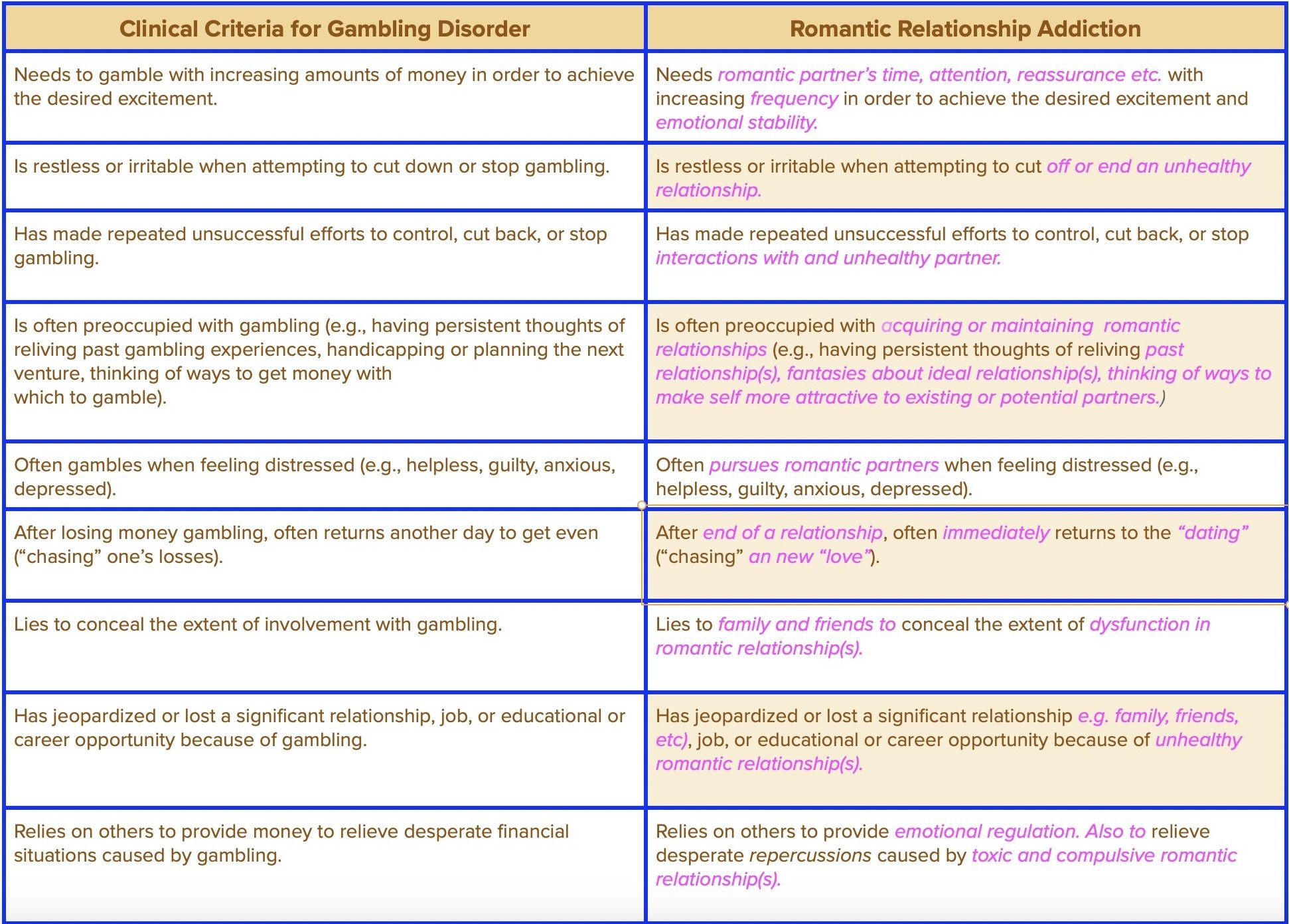Healing Love Addiction pt 1 (pt 5/6)
Let’s recap…
We’ve learned Romantic Relationship Addiction -RRA commonly know as Love Addiction - LA is :
… “the maladaptive craving for, and pursuit of romantic relationships to experience a euphoric high or powerful sense of security and worth that will tranquilizes one’s loneliness and affective distress. Craving and pursuit continues despite causing harm or negative consequences. Loss of control, tolerance, and withdrawal also develop. Two subtypes —attraction phase and attachment phase refer to the phase of the relationship that the patient most craves”
(Levounis et al., 2015 p 154)
*Romantic Relationship Addiction (RRA) and Love Addiction/ Love Addict(s) (LA) are use interchangeably. Too Much of A Good Thing?
*RRA/ LA is not a recognized diagnosis in the DSM-V-TR .
However, many of RRA/ LA’s symptoms meet the criteria for substance use disorder (formerly known as addiction).
The resistance to categorizing “Love Addiction” as a disorder comes down to a simple question. “How can something as natural, necessary, wholesome, and aspirational as “Love” be an addiction”? The answer is simple, it can not.
“Reciprocal Romantic Love” consists of:
-Mutual Respect - Honesty -Integrity -Compassion -Commitment -Authenticity -Kindness -Communication -Boundaries-Shared Values -Encouragement -Affection
(Levounis et al., 2015)
Those struggling Romantic Relationship Addiction/ Love Addiction, desire “Love” but are stuck in a cycle of harmful habits, behaviors, and attachments. These behaviors are rooted in trauma, an impaired sense of self worth, and a debilitating fear of abandonment and being alone.
Behaviors and Addiction
Because pathological behaviors have such a substantial impact on how those with RRA relate and function, it makes sense to compare how RRA compares to the Behavioral Addiction of Gambling Disorder.
*Gambling Disorder: Persistent and recurrent problematic gambling behavior leading to clinically significant impairment or distress, as indicated by the individual exhibiting four (or more) of the noted behaviors in a 12month period:
Romantic Relationship Addiction Cycle
Romantic Relationship Addiction, has countless presentations. However, many with RRA have cyclical patterns within intimate relationships. Some individuals continually go through the cycle, swiftly moving from Love Interest to Love Interest. While others, have long pauses between relationships. Frequency aside, the four features of RRA consist of:
RRA CYCLE
A feeling of instant and intense physical and emotional attraction
A period of fantasy and idealization
A shift in dynamics and cracks in fantasy
A collision with reality and imminent demise of the fantasy. This often results in emotional turmoil for the RRA and reinforcing feelings of emptiness and low self esteem.
The Roots and Results of RRA/LA
It All Started When…
I’ve found the origin story of LAs have a common narrative of “Not Being Enough”. The details of each person’s story may be different, but there is almost always some unattainable ideal the LA believes they can’t meet. The LA constantly comparisons themself to others. This reinforces the the cornerstone beliefs that they are unworthy, unlovable, and not good enough.
This core belief may have begun early in life, or reared its head during adolescence and young adulthood. At some point, the LA experiences some form of trauma, resulting in a wounded sense of self.
Romantic relationships, offer a sense of relief, purpose, value, identity, and in some instances status. The meer thought of losing or not having a romantic partner can be utterly destabilizing for the LA.
Fear and emotional distress often result in the LA going to extremes to avoid real or perceived abandoment. The irony is, attempts to avoid abandonment cause the LA to engage in self abandonment.
From Self Abandonment to Self Acceptance
Somewhere along the way, the LA leaves them self behind. They trade their, preferences, priorities, values, and boundaries for acceptance of another. The LA may not even recognize their self.
Healing from LA/ RRA begins with getting reacquainted with one’s self. Through Validation, Compassionate Inquiry, Critical Contextualization, and Practical Integration, self abandonment can transform into self acceptance. Love Addiction can be healed and one can feel at home in their own heart and life.
….Part 2 ——>
Works Cited
Levounis, P., Ascher, M. S., Briggie, A., & Briggie1, C. (2015). Love Addiction: What’s Love Got to Do With It? In The behavioral addictions (pp. 153–173). essay, American Psychiatric Publishing, Inc.
Rothbaum, F., Weisz , J., Pott, M., Miyake, K., & Morelli, G. (2000, October). Attachment and Culture: Security in the United States and Japan. Harvard.edu. https://weiszlab.fas.harvard.edu/files/jweisz/files/rothbaum_et_al_2000_j_ch_fam_studies.pdf
Tawwab, N. G. (2023). Drama free a guide to managing unhealthy family relationships. TarcherPerigee, an imprint of Penguin Random House c 2023.
Taylor, J., & Shrive, J. (2023). Indicative trauma impact manual: Itim for professionals: A non-diagnostic, trauma-informed guide to emotion, thought, and behaviour. VictimFocus.





